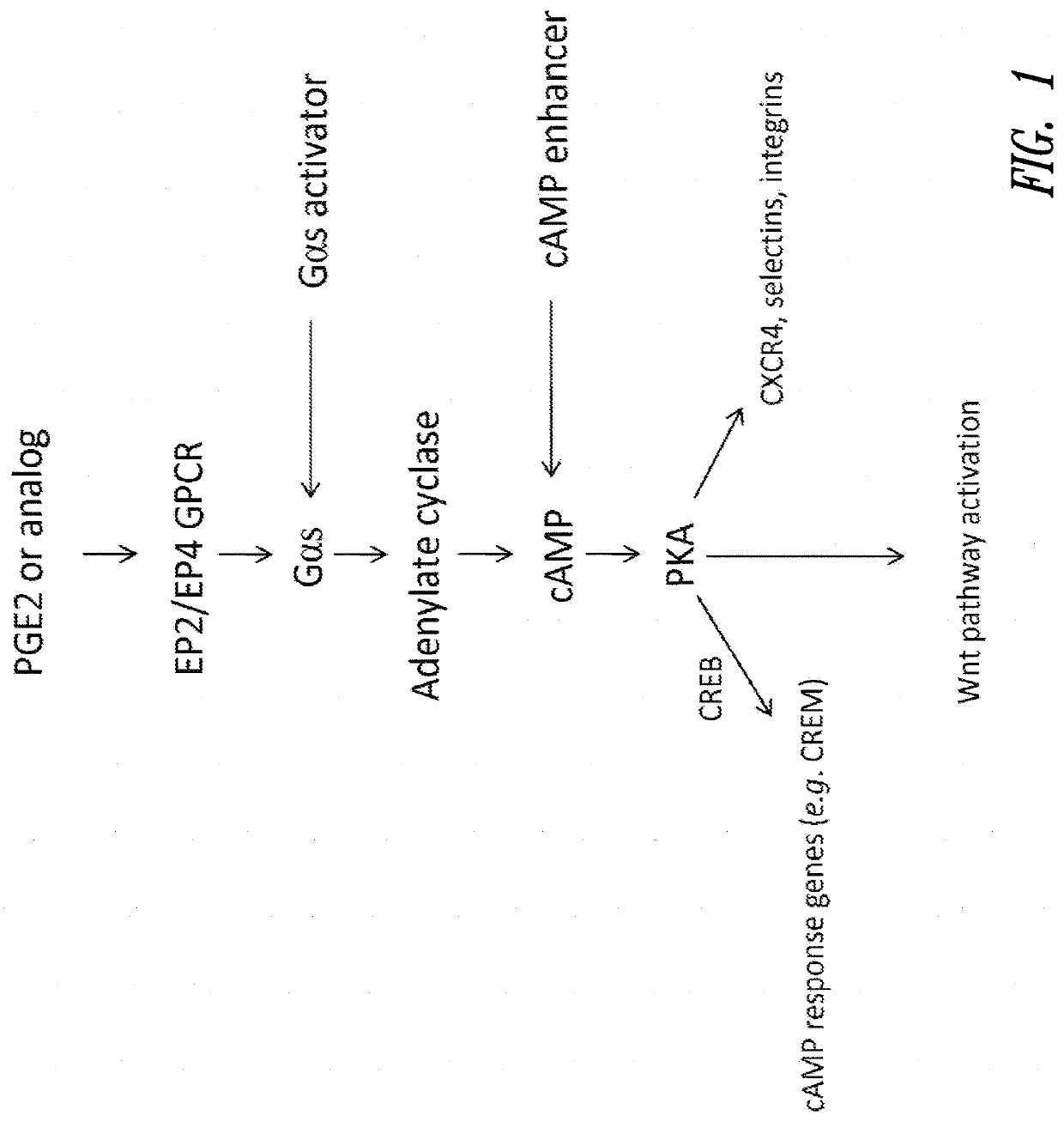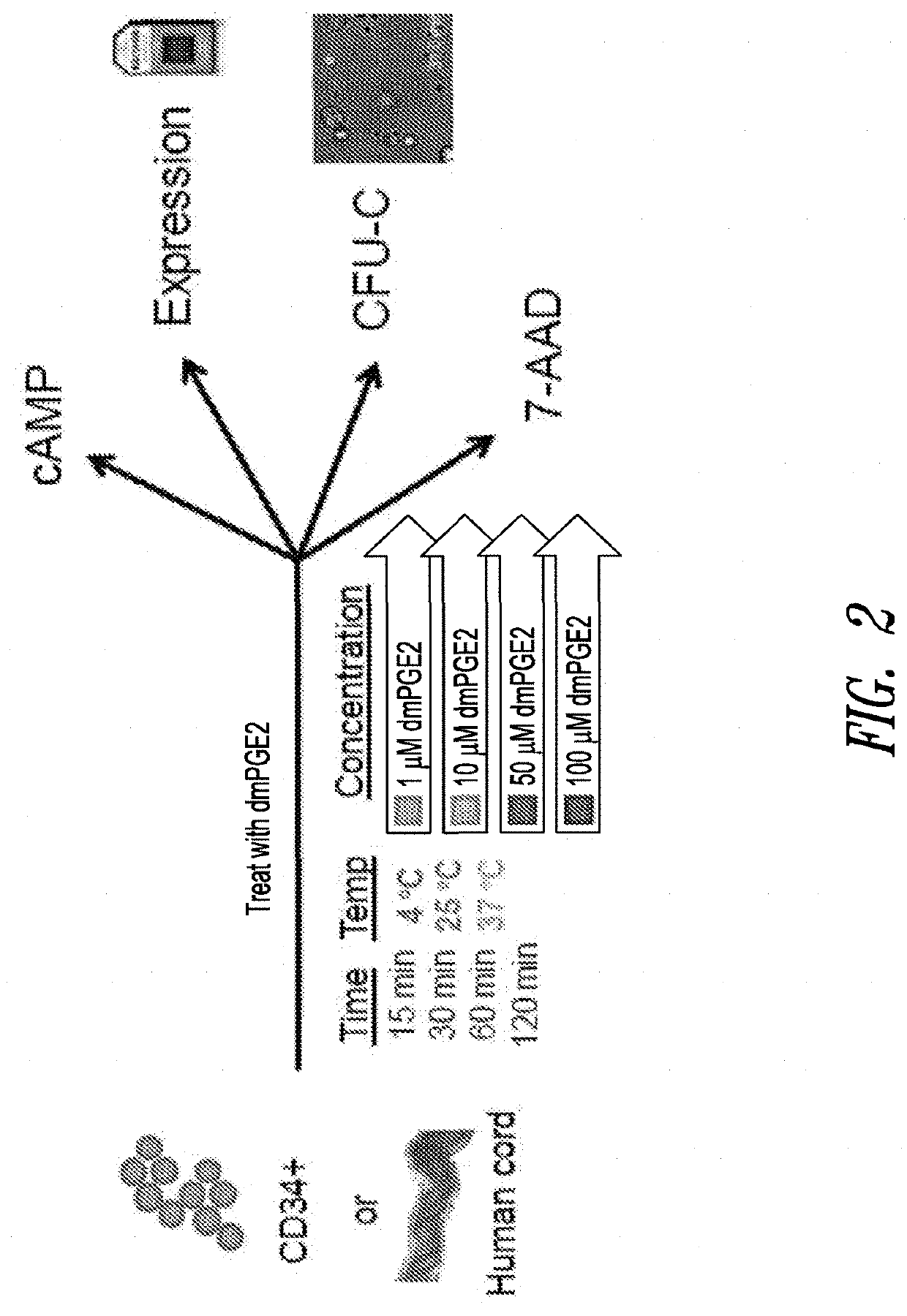Hematopoietic stem and progenitor cell therapy
a hematopoietic stem and progenitor cell technology, applied in the field of cell therapy, can solve the problems of life-threatening, difficult and time-consuming to find the requisite degree of hla donor matched tissue, and allogeneic bone marrow transplants are often associated with a significant incidence of graft-versus-host disease, so as to improve the hematopoietic stem and progenitor cell transplantation method, improve the engraft potential
- Summary
- Abstract
- Description
- Claims
- Application Information
AI Technical Summary
Benefits of technology
Problems solved by technology
Method used
Image
Examples
example 1
Competitive cAMP Assays
[0351]The cAMP assay was performed on CD34+ cells using the LANCE® cAMP detection kit (Perkin Elmer Inc., Waltham, Mass.) according to the manufacturer's instructions. Briefly, 3,000 CD34+ cells (Stem Cell Technologies, Vancouver, Canada) were aliquoted in each well of a 384-well opaque white plate in the recommended stimulation buffer. Assays were performed in triplicate for all conditions.
[0352]CD34+ cells were placed on ice prior to being stimulated with DMSO or 16,16-dimethyl PGE2 at 4° C. For assays conducted at other temperatures, e.g., 25° C. or 37° C., DMSO or 16,16-dimethyl PGE2 was added to CD34+ cells at room temperature and then the plates were incubated with DMSO or 16,16-dmPGE2 at the experimental temperature (25° C. or 37° C.).
[0353]CD34+ cells were incubated for periods of 5, 15, 30, 60 or 120 minutes. Following the incubation period, detection buffer was added to the stimulated cells and cells were incubated for an additional 1 hour at room te...
example 2
Gene Expression
Whole Genome Expression Arrays
[0357]Human umbilical cord blood and pre-isolated CD34+ cells from human umbilical cord blood were purchased from Stem Cell Technologies Inc. (Vancouver, BC, Canada). Cells were incubated in either low molecular weight dextran with 5% human serum albumin media (LMD / 5% HSA) or Stem Span media (Stem Cells Technology Inc.) for ex vivo treatment with 16,16-dimethyl PGE2. Total RNA was isolated from incubated cells using a Pico Pure RNA Isolation Kit (Molecular Devices, Sunnyvale, Calif.).
[0358]Biotinylated amplified RNA (aRNA) was prepared using the standard protocol for MessageAmp II aRNA Amplification Kit (Applied Biosystems / Ambion, Austin, Tex.) and the optional Second Round Amplification; the copy RNA (cRNA) was transcribed into biotin labeled aRNA using MessageAmp II Biotin Enhanced Kit (Applied Biosystems / Ambion, Austin, Tex.) according to the manufacturer's instructions. Biotin labeled aRNA was purified and fragmented according to the ...
example 3
Cell Viability Assays
[0384]Whole cord blood cells or CD34+ cells obtained from Stem Cell Technologies (Vancouver, Canada) were aliquoted equally in Eppendorf tubes and treated ex vivo at a range of 16,16-dimethyl PGE2 concentrations (10 μM to 100 μM) or DMSO control; temperatures (4° C., 22° C., or 37° C.) for 60 or 120 minutes in LMD / 5% HSA media. After treatment, an aliquot of the incubated cells were assayed using 7-Amino-Actinomycin D (7-AAD) staining as an indicator of cell death. One million whole cord blood were stained with 5 μL of 7AAD staining solution (BD Bioscience, San Jose, Calif.), or 200,000 CD34+ cord blood cells were stained with 1 μL 7-AAD solution. Cells were analyzed on a Guava EasyCyte 8HT System (Millipore) and with the FlowJo software package (Tree Star Inc., Ashland, Oreg.). A separate aliquot of the same cells were also taken for assessment of proliferation potential using CFU-C assays (discussed below in Example 4).
[0385]The results showed that whole cord ...
PUM
| Property | Measurement | Unit |
|---|---|---|
| temperature | aaaaa | aaaaa |
| time | aaaaa | aaaaa |
| time | aaaaa | aaaaa |
Abstract
Description
Claims
Application Information
 Login to View More
Login to View More - R&D
- Intellectual Property
- Life Sciences
- Materials
- Tech Scout
- Unparalleled Data Quality
- Higher Quality Content
- 60% Fewer Hallucinations
Browse by: Latest US Patents, China's latest patents, Technical Efficacy Thesaurus, Application Domain, Technology Topic, Popular Technical Reports.
© 2025 PatSnap. All rights reserved.Legal|Privacy policy|Modern Slavery Act Transparency Statement|Sitemap|About US| Contact US: help@patsnap.com



